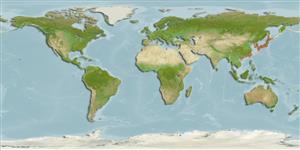Common names from other countries
Environment: milieu / climate zone / depth range / distribution range
Ecologia
; estuarina; intervalo de profundidade 0 - 6 m (Ref. 385). Subtropical
Northwest Pacific: from south of Japan to the south of Sakhalin.
Length at first maturity / Tamanho / Peso / Idade
Maturity: Lm ?, range 2 - ? cm Max length : 4.0 cm SHL macho/indeterminado; (Ref. 127304); Idade máx. registada: 10 anos (Ref. 127304)
Found in subtidal areas of estuaries in mud (Ref. 75831). Infaunal suspension-feeder (Ref. ).
Life cycle and mating behavior
Maturidade | Reprodução | Desova | Ovos | Fecundidade | Larvas
Life cycle: Embryos develop into free-swimming trocophore larvae, succeeded by the bivalve veliger, resembling a miniature clam (Ref. 833).
SAUP Database. 2006. (Ref. 356)
Status na Lista Vermelha da IUCN (Ref. 130435)
Status no CITES (Ref. 108899)
Not Evaluated
Not Evaluated
Uso pelos humanos
Pescarias: espécies comerciais
FAO - pescarias: landings, perfil da espécie | FishSource | Sea Around Us
Ferramentas
Fontes da internet
Estimates based on models
Preferred temperature
(Ref.
115969): 5.6 - 22.6, mean 14 (based on 372 cells).
Resiliência
Elevada, tempo mínimo de duplicação da população menor que 15 meses (K=0.2-1.11; tm=3; tmax=10).
Categoria de preço
Unknown.
